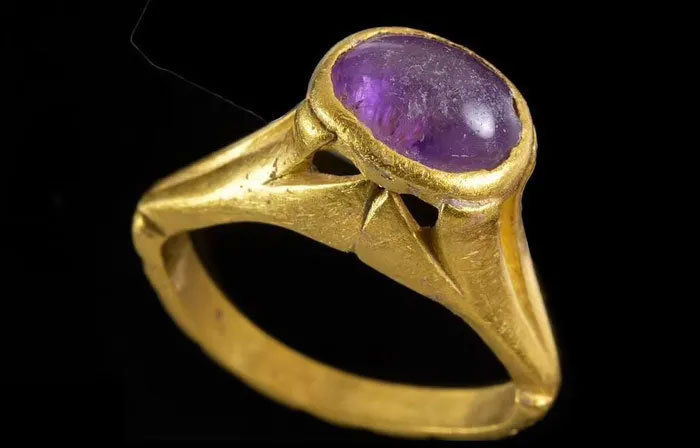Archaeologists have discovered a gold ring set with an amethyst at the largest ancient winery in the world, located in Israel.
In the ancient world, dating back to the time of the Greeks, amethyst was widely believed to have protective properties and was commonly used. One of the ancient applications of amethyst was to mitigate the effects of alcohol.
The owner of the ring was likely a wealthy individual who frequently tasted or consumed large amounts of wine.

Beautiful amethyst ring found within the largest Byzantine winery in the world.
The ancient gold ring, featuring a large and exquisite amethyst, was uncovered during an excavation led by the Israel Antiquities Authority in the city of Yavne, central Israel.
This site is home to the largest winery from the Byzantine era, spanning nearly 7,000 square meters and producing 2 million liters of wine annually during its early days.
The purple stone at the center of the ring belonged to a wealthy individual of high status who lived around the 7th century CE. Experts suspect that the last wearer before it was lost was a wine taster at the winery. In the ancient world, it was believed that the purple stone helped its owner avoid the harmful effects of alcohol.
Amethyst is a crystalline quartz that ranges in color from light lavender to deep purple, and it is one of the 12 stones set in the breastplate of the high priests.
Dr. Amir Golani, an expert in ancient jewelry at the Israel Antiquities Authority, stated: “The ring belonged to a wealthy individual, and the wearing of a gold ring set with amethyst indicates their high status and wealth. Both men and women could wear this gold amethyst ring.”
The authorities are currently determining the exact age of the ring. Archaeologists have found the ring in layers of soil dating from the late Byzantine period to the early Islamic period, around the 7th century CE. The ring is estimated to be about 1,400 years old.

The largest Byzantine winery in the world.
Experts suggest that such a ring could have been a family heirloom passed down through generations for centuries.
Amir Golani noted: “In fact, gold rings set with amethyst were very popular in the Roman world. The ring of a wealthy individual living in Yavne in the early 3rd century CE could have been an object passed down from generation to generation.”
The Byzantine Empire existed from around 330 to 1453, becoming one of the most powerful civilizations in the world.
Archaeologists spent two years excavating the vast site of the largest winery of that time. They uncovered five large wine presses, storage facilities, and even kilns, along with clay jars used for storing wine. The winery produced the famous Gaza and Ashkelon wines, a renowned brand in the ancient world.


















































